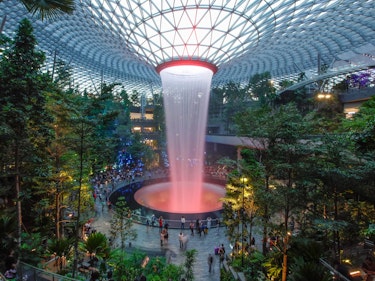Singapore, a city-state often referred to as the “Garden City,” is a melting pot of cultures, innovation, and design excellence. Its urban landscape is a harmonious blend of cutting-edge modernity, sustainability, and historical preservation. Each structure is thoughtfully crafted, serving not just a functional purpose but also a symbolic one, reflecting the city’s ethos and ambition. From soaring skyscrapers to verdant public spaces, Singapore has become a global beacon for architecture and urban planning, showcasing how nature and modernity can thrive together.
This article explores 7 of Singapore’s most iconic architectural masterpieces, each contributing to the city’s global reputation as a hub of design ingenuity and environmental sustainability. These landmarks offer a glimpse into Singapore’s ability to balance its aspirations for the future with respect for its past, a balance that makes it an inspiring case study for architects, urban planners, and design enthusiasts worldwide.
1. Marina Bay Sands
Marina Bay Sands is arguably Singapore’s most recognized landmark and a symbol of its global prominence. Designed by the renowned architect Moshe Safdie, this integrated resort redefines luxury and engineering. The three 57-story towers are topped by the SkyPark, a cantilevered platform that houses restaurants, observation decks, and the world’s largest rooftop infinity pool. More than a stunning visual feat, it represents Singapore’s bold vision and its ability to execute projects of monumental scale with precision.

Credit: Agoda.com
2. Gardens by the Bay
Gardens by the Bay is a 101-hectare futuristic park that epitomizes Singapore’s dedication to sustainability and biodiversity. The Supertree Grove, with its towering vertical gardens, is both an aesthetic marvel and an engineering triumph, housing solar panels and rainwater collectors. The Flower Dome and Cloud Forest, two of the world’s largest climate-controlled glass greenhouses, further illustrate how architecture can integrate technology and environmental consciousness.

Credit: Visit Singapore
3. The Esplanade – Theatres on the Bay
Nicknamed “The Durian” for its spiky facade, the Esplanade stands as a cultural and architectural beacon. Its design is inspired by the local tropical fruit and was crafted to achieve world-class acoustic performance within its concert halls. The structure reflects Singapore’s efforts to position itself as a hub for arts and culture in Asia, blending aesthetic appeal with function.

Credit: Visit Singapore
4. Jewel Changi Airport
Jewel Changi Airport is more than an airport —i t’s a destination in itself. The iconic Rain Vortex, a 40-meter indoor waterfall, anchors the space, while the surrounding Shiseido Forest Valley invites visitors to explore lush greenery. Designed by Moshe Safdie, Jewel exemplifies how architecture can elevate everyday spaces into extraordinary experiences. It integrates leisure, retail, and natural elements, redefining what an airport can be.

Credit: Condé Nast Traveler
5. National Gallery Singapore
This gallery is a powerful representation of Singapore’s ability to weave historical preservation into modern innovation. Housed in two historic buildings—the former Supreme Court and City Hall— it celebrates the nation’s artistic heritage. Studio Milou Architects meticulously blended colonial architecture with contemporary glass and steel structures, creating a seamless dialogue between the old and the new.

Credit: Singapore Tickets
6. ArtScience Museum
The ArtScience Museum, shaped like a blooming lotus, is an architectural symbol of Singapore’s dedication to creativity and innovation. Designed by Moshe Safdie, the museum’s form reflects its function as a bridge between art, science, and technology. Its central oculus collects rainwater, channeling it into a waterfall feature, seamlessly combining sustainability with artistic expression.

Credit: Safdie Architects
7. Henderson Waves Bridge
The Henderson Waves Bridge connects Mount Faber Park to Telok Blangah Hill Park, creating a seamless link between nature and design. Its wave-like wooden structure is a masterpiece of engineering, curving organically to harmonize with the surrounding environment. The bridge offers panoramic views of the city and is a favorite among nature enthusiasts and photographers.

Credit: Archello
Singapore’s architectural landscape is a living narrative of its evolution, balancing its aspirations for a sustainable future with a reverence for cultural heritage. From futuristic designs like Marina Bay Sands and Gardens by the Bay to the historical elegance of Raffles Hotel and Peranakan houses, each structure tells a story of ambition, creativity, and respect for the environment.